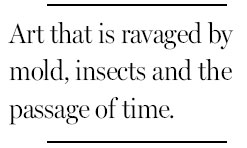
|
Photographs by Suzanne Dechillo / The New York Times |
|
Einar, Bjorn and Oddur Roth continue their collaboration with Dieter Roth in a show in New York. Dieter Roth died in 1998. |

Over the last half-century few artists have explored impermanence quite as thoroughly as Dieter Roth, the wildly experimental Swiss-German jack-of-all-trades who died in 1998.
Many of his signature materials were things you eat, not make art with: chocolate, cheese, sausages. For his first show in the United States, at the Eugenia Butler Gallery in Los Angeles in 1970, he filled 37 suitcases with cheeses and allowed nature to take its course, bringing flies, maggots and the health authorities. His "self-portraits" were mainly abstractions parading as pictures of inanimate objects: a flower pot, a mountain, a pile of dog feces.
"I experience my person," he said, "as a nebulous persona."
So it made some kind of sense, on a recent visit to a New York gallery filled with work mostly by Dieter Roth, to find a middle-aged man who looked mostly like him supervising the installation. The man was in the midst of an intense discussion with two younger men, whose faces were variations on his own.
The men - Dieter's son, Bjorn Roth, 51; and Bjorn's sons, Oddur, 29, and Einar, 24 - represent the second and third generations of what might be described as a persistent Roth art organism. The exhibition they have been building, "Dieter Roth. Bjorn Roth," to inaugurate a space for the international gallery Hauser & Wirth, is a messy manifestation spanning more than 40 years of work.
Dieter Roth believed in collaboration - with artists, collectors and family. Dieter's influence has only grown since his death at the age of 68. "He was completely at odds with the history of how an artist works," said Gary Garrels, who helped organize a retrospective of Roth's work that was shown in 2003 and '04. "There was no standard operating procedure."
Dieter Roth was born in Germany in 1930 and raised in Switzerland. In 1957 he moved to Iceland to follow Sigridur Bjornsdottir, the Icelandic woman he would soon marry. Although he took up a peripatetic life he remained close to his family and by the 1970s his three children, Karl, Bjorn and Vera, began to make work with him and to be credited along with him.
At 17, Bjorn began working with his father and their collaboration yielded hundreds of works. Still, he said, "I'm not pretending to be Dieter in this. He was a genius, and that's very rare."
Dieter Roth often made works by arranging foods on paper or fabric under glass or plastic, allowing oozing, mold and insects to continue the work.
For the New York show the Roths are continuing one of the most monumental food-based works, towers of busts made from chocolate and sugar. The concept, first explored by Dieter in 1968, involved a bust self-portrait of what he might look like as an old man, rendered in chocolate, and other busts that were supposed to represent lions but looked more like dogs, made from brightly colored sugar.
"I always saw this piece in a way as a poem instead of being like a building," Bjorn said. "In the first of these works, the heat and humidity were allowed to work on the chocolate, and the heads at the bottom get pressed down and they get a very sad face, like this." He pretended to squash his face with his hands, closing his eyes and flattening his mouth. "They look like the whole weight of the world is pressing down on top of them."
Oddur, who was 16 when Dieter Roth died, said, "It's quite weird when you're young in school and the teacher asks you what you did over the summer, and you say you went with Grandfather to the grocery store and bought some salamis and bolognas and sliced them up and spread them on a carpet and then drew lines around the circles of fat they made. They think you're an incredible liar."
Mr. Garrels, now a curator at the San Francisco Museum of Modern Art, said Dieter Roth's most important collaborator was time - "be it through mold or insects or other organic processes, allowing things to continue to change," adding, "This kind of work is very much in that spirit."
The piece in the gallery space that might embody the spirit most fully is "Grosse Tischruine" or "Large Table Ruin," composed of tables and chairs piled with all manner of detritus. Dieter would add to the agglomeration each time it was exhibited.
"It was very difficult to install this piece when Dieter was alive," Bjorn said, "because you would buy a new tool, say, and if you weren't careful, the next time you turn around, it's glued to a table."
The New York Times
(China Daily 02/03/2013 page12)
